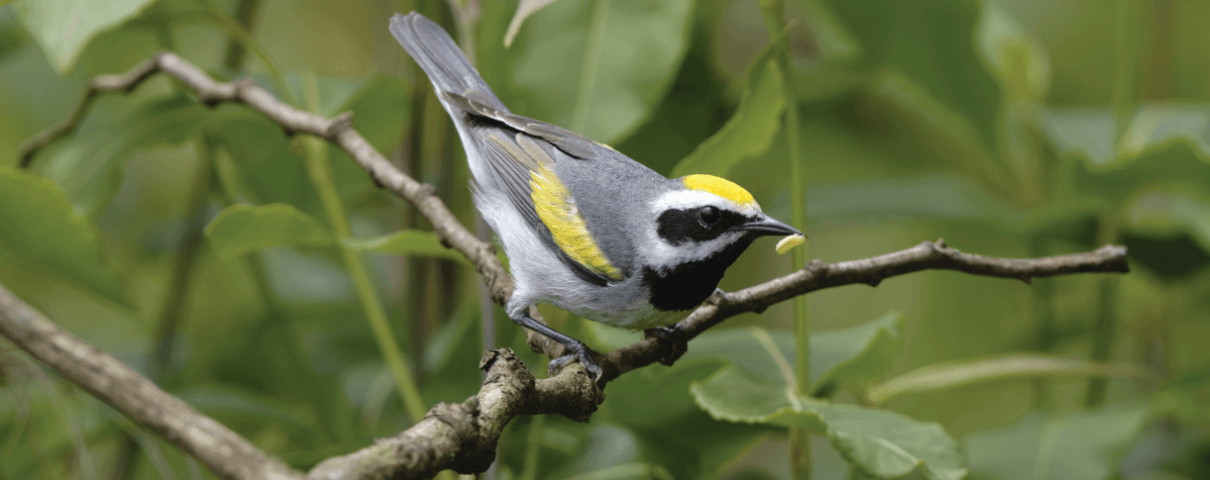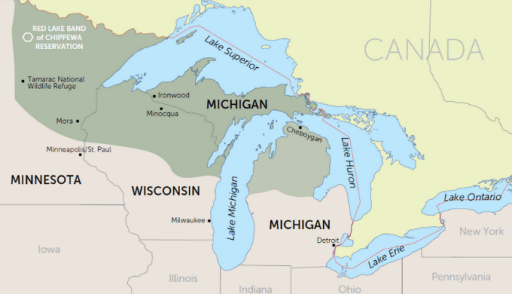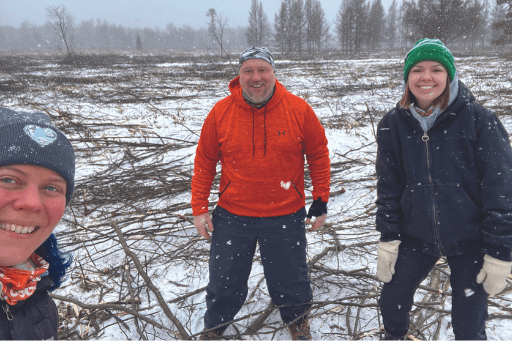Building a Northwoods Nest-Egg
Around the Great Lakes, momentum grows to restore and enhance landscapes, brightening the future for birds and people.
You may have read that nearly 3 billion birds have been lost since 1970. And you probably know that two culprits suspected in this widespread decline are habitat loss and fragmentation.

What if there were a huge area where declining birds had the space to rebound? And what if this idyllic place brought together public and private land stewards, foresters, conservationists, hunters, and birders — all working for a common cause? In trying times, here's some good news: This is actually happening.
The Northwoods of Minnesota, Wisconsin, and Michigan constitutes a vast mosaic of forested habitats dotted with lakes and threaded by rivers and streams. There, boreal forest meets broadleaf or deciduous forest, at the east end of the Great Plains prairie zone. Big on trees and small on human population, this expanse stretches across an area the size of Pennsylvania and New York combined. For a sense of scale, it takes less time to drive from Detroit to Washington, D.C., than within Michigan from Detroit to Ironwood, in the state's far northwest corner — a route arcing through a hearty helping of that state's 20 million forested acres.
The story of how bird conservation is becoming part of the fabric of land management across this broad “woods-scape” is written by people seeing the land in more than just board-feet or strict-protection terms. It involves careful consideration and planning, including deciding where trees should be cut as well as where they should stay.
Ways of the Warbler

Among other species, the Northwoods is the stronghold of the Golden-winged Warbler, a flashy silver, black, white, and gold sprite now gone from many other parts of its historical breeding range. Half the remaining breeding population nests in northern Minnesota alone, with substantial populations in Wisconsin and Michigan as well. The region's vast forest tracts provide a “safety zone” for this bird from heavy cowbird parasitism that occurs in fragmented forests, and from competition from and interbreeding with the closely related Blue-winged Warbler, which generally does not occur this far north.
Although the area in forest here is great, what is now lacking is a broad distribution of early successional or young deciduous forest habitats with scattered mature trees — the kinds of places where golden-wings proclaim their territories and build their nests. And it turns out that birds nesting in shady forest need these sunny habitats as well.
Dynamic Birds, Dynamic Forests
A few decades ago, biologists started radio-tagging nestling forest birds and following their movements after they fledged. They found that Wood Thrushes and other birds that nest in older forest often take their fledglings to nearby shrubby young forest, where there is an abundance of insects, berries, and cover. And it turns out that the Golden-winged Warbler does the opposite — nesting in scrub, with fledglings then heading to adjacent older woods rich in caterpillars and other sustenance. These habitat change-ups illustrate how birds need different habitats at different life-cycle stages. This revelation was a game changer for conservationists.

“We were once happy looking at just nesting success … but there's a whole lot more that happens to the young birds once they leave the nest,” says Jeff Larkin, a biologist, forester, and professor at the Indiana University of Pennsylvania who has served as ABC's Eastern Forest Birds Habitat Coordinator since 2012.
“It turns out for many species that there's a switching of habitat structure as young birds grow, molt, learn to forage, and evade predators,” Larkin says. “When they leave the nest, these birds are just blobs of feathers trying to grow as fast as they can. When you think of the constraints, it's pretty easy to make the connection that if you don't have diverse forest conditions these birds need juxtaposed to each other, you're really not benefiting forest birds as much as you could.”
Larkin heads up an initiative called the Dynamic Forest Partnership that is spreading across Appalachia and into Great Lakes states. The partnership strives to create and maintain an array of habitats across large forest blocks. This “forest dynamism” addresses many forest birds' needs, and hits a sweet-spot where states' wildlife and forest goals converge.
“I was reading both state forest action plans and wildlife action plans,” Larkin says, “and it hit me: Both were saying habitat is degraded, and some forest community types and age-classes are not as available as they should be. And, sure enough, on both the forestry and wildlife fronts, there was positivity for our effort from the start.” With funding from the National Fish and Wildlife Foundation, matched by an array of public and private agencies and organizations, the partnership has enrolled more than 250,000 acres.
Covering a Lot of Ground
The quarter-million-acre figure above does not include the work of ABC's Great Lakes habitat conservation team, although they espouse Larkin's strategy. While a good portion of their work focuses on Golden-winged and Kirtland's Warblers, they also aim to restore and enhance habitat to support at least 20 other declining species, ranging from the Blackburnian Warbler to the Broad-winged Hawk and American Woodcock.
The team includes eight full-time foresters. Peter Dieser, ABC's Great Lakes Public Lands Director, is one of them. Each year, he and federal, tribal, state, and local partners enhance roughly 1,000 acres in northern Minnesota to optimize habitats for birds. Since he took on his job in 2013, Dieser has been involved in projects affecting 7,550 acres on public and tribal lands. “I've loved putting my blood, sweat, and tears into building something from the ground up that is generally considered a conservation success story in this state,” he says.

Dieser and his teammates know that restoring and enhancing forest lands takes a careful eye. “The retention of trees and other woody vegetation is at least if not more important than what you cut,” he says.
“Each property is slightly different and each landowner is different,” adds ABC Michigan Forester Michael Paling. “We do have to think about a lot of different things, such as forest and soil types, because these details point us toward which wildlife might use the area and, in turn, which management practices we ultimately use.”
The Great Lakes team covers a lot of ground. ABC Michigan Private Lands Forester Joyanne Mittig, for example, has a “beat” of 27 counties in the “tip of the mitt” of her state's Lower Peninsula. “I work with landowners to educate them about their forests and wildlife — from timber harvests to invasive species management, wildlife habitat, and tree planting.”
Paling, Mittig, and others on the team work with interested private landowners to survey their acreage, draw up forest plans, and help them find federal funding through the U.S. Department of Agriculture's (USDA's) Natural Resources Conservation Service (NRCS). This funding helps defray some of the costs of noncommercial habitat work, which often requires hiring contractors, and provides an incentive for commercial timber harvesters to use best-management practices for creating young-forest wildlife habitat. Actions that optimize forest diversity include: creating gaps, working around “legacy patches” of untouched habitat, and leaving snags — dead or dying trees used by wildlife for nesting and shelter. All told, ABC efforts on private land have impacted more than 6,770 acres in Minnesota, Wisconsin, and Michigan.
Buzz-cutting Alders

Some land-management practices are now considered essential in recreating a cycle of disturbance that keeps ecosystems vital. Controlled burns and thoughtfully orchestrated timber harvesting are examples of disturbances that can be used to recreate this cycle over time. Another that provides quick benefits is “alder shearing.”
The native Speckled Alder occurs throughout the region in damp, forested habitats. This vigorous plant grows as a shrub or small tree, often in tight clusters that become so tall and so dense that after ten to 15 years, they stifle other plant growth and animal movements. Just as gardeners learn that pruning is a careful and important art that keeps plants healthy and compact, conservation foresters target the fast-growing alder to optimize its use on the landscape.
Most sites slated for shearing by ABC and partners are alder monocultures that haven't been thinned by a natural disturbance event or other clearing in decades. What's often needed is what Paling likes to call “giving the land a haircut.”
“We use silviculture to mimic what natural disturbances would do,” says ABC Wildlife Habitat Specialist Pat Weber. Alder shearing is done with skid steers equipped with special mulching attachments, or “bush-hog” rotary mowers, or bulldozers. The work is mostly done in the dead of winter, when the ground is frozen solid and plant and animal life is dormant. Large alder shrubs get trimmed down, while any occurring mature trees and most, if not all, other saplings are left.
Duane Fogard, who has worked as ABC's Habitat Forest Lands Forester in Minnesota for nearly seven years, explains that to the untrained eye, the aftermath of this winter work “might at first look harsh or ugly to some, but I guess you don't make an omelet without breaking a few eggs.” The benefits become clear once spring arrives.

“After this work, the sunlight that was filtered out by large woody alders gets to the ground,” says Fogard, “and many seeds that stayed viable in the soil for years and years will go crazy and start to grow with the overstory gone.”
Newly created sunny patches flush with Beaked Hazelnut, blueberry, and other shrubs and are painted with the blooms of goldenrod, aster, milkweed, and Marsh Marigold — magnets for bees, butterflies, and hummingbirds. This habitat attracts not only the Golden-winged Warbler and other songbirds, but also game species such as the Ruffed Grouse, Wild Turkey, and American Woodcock, which in turn draw predators including the Fisher, a large member of the weasel family that has been declining in many parts of its range.
As for the cut alders: “Our main goal is to leave the roots undisturbed, so they will re-grow,” says Linnea Rowse, ABC's Great Lakes Private Lands Director. In a forest opening or wetland edge, young, recently sheared alders rapidly rebound in the sun. Their roots help fix nitrogen in the soil, and their fresh leaves and drooping catkins teem with insects that feed a bounty of wildlife.
“What we're doing here is trying to mimic disturbances with young, vibrant growth in close proximity to older deciduous forests,” says Rowse, “and we are thinking about this on the landscape level. That way, some percentage of this early successional forest will always be around.”
Making the Most of Their Land

Wisconsinite Todd Berg is a great fan of these efforts. He worked with his state's department of natural resources and the USDA on five acres of his land near Phillips, Wisconsin. Then he worked with ABC to secure plans and funding for seven more acres, with another eight planned for next year.
“There's nothing we've done to our land that compares to the effectiveness of the young forest cuts,” he says. “They've turned those areas into living zoos.” Within a day of the first alder shearing, Berg and his wife saw a Fisher, the first they had ever seen. The following spring, they started hearing woodcock there.
“Woodcock used to be very hard to find,” says Berg. “Now, we see them all the time. In fact, we've seen more woodcock in the last few years than we've ever seen before.” This is good news because this cryptically colored, worm-hunting “land shorebird” has steadily declined across its range over the last 25 years.
Berg's efforts inspired others to boost their land's productivity for wildlife. “Our neighbor saw what we were doing,” he says. “Then three years ago, he had 11 acres done. It's helping everything: for us, for him, for county land. The magnetism to wildlife is just incredible.”
Meanwhile, in Mora, Minnesota, north of Minneapolis, Jim Morrison and his family are trying to make the most of their 172 acres. “When we acquired this piece of property in 1997 and it became our home,” Morrison says, “we thought: How can we make this what it was supposed to be?” Hunters, fishers, campers, and bird-lovers, the Morrisons considered the counsel of many agencies and organizations. “We decided we'd create and foster as much complexity as we can and then let things take their natural course,” Morrison says. He began working with ABC's Fogard on Golden-winged Warbler patches, and remarks: “He helped us work with a small logging company to do the project to create succession where a lot of the wooded area was one generation.”

“We have heard Golden-winged Warblers on our property in recent years,” Morrison says. Plus, there is now a new patch flush with young poplars just reaching the ideal age for enticing warblers. He is optimistic that they soon will confirm nesting there.
Just outside of Cheboygan, atop Michigan's Lower Peninsula, Chris Tracy and his family have been following a forest plan on their 500 acres since 2004. Working with ABC's Paling and Mittig and other partners, the Tracys improved 30 acres for golden-wings, and they are targeting 30 more, in addition to planting native trees. “We've learned a lot through the process,” Tracy says, “and we get way more out of it than we put into it. It's meaningful to us on so many fronts.”
Growing Canvas, Ready Roadmap
On private and public lands, ABC will continue its work across the expansive Northwoods. The canvas keeps growing: ABC recently joined Sustainable Forestry Initiative (SFI) and the University of Alberta's Boreal Avian Modeling Project on a cross-border effort to “assess and demonstrate the value of SFI-certified forests to important bird populations.” This analysis focuses on 56 million acres of certified forests across Wisconsin, Minnesota, Michigan, and Ontario and will help planners understand more clearly which types of management best meld commercial and conservation efforts for birds and other wildlife.
Together, many partners across the Northwoods now see the forest for more than the trees, and the birds as an important part of the plan. In many other parts of the world, this success story could provide an inspiring roadmap leading to a brighter future elsewhere for birds and people.
 | Howard Youth is ABC's Senior Writer/Editor, and is the author of Field Guide to the Natural World of Washington, D.C. |


















































